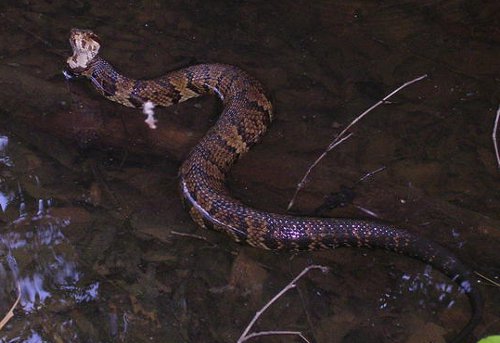
Cottonmouth/Water Moccasin
(Agkistrodon piscivorus)[5]
 |
| Range of Cottonmouths in North Carolina[4] |
Description:
| Cottonmouth warning[6] |
Dark olive Cottonmouth blending[7]
Toxins and Bite Statistics:
The toxin itself is a hemotoxin, meaning it effects the proteins of the blood and surronding tissues. The Cottonmouth venom can cause an inability to clot in the blood and lysis (bursting) of red blood cell. If bitten by a hemotoxic snake, it can cause quick loss of blood as well death of surronding tissues (Wilson 2003). While the Cottonmouth does not have a rattle, it does hiss and uses its large white mouth as a way to intimidate and stand its ground. The Cottonmouth will also use its ability to swim easily as an escape route if confronted. The hemotoxin it uses is very similar to the Copperhead in how it effects the body and to what extent it can degrade the skin (Louis 2016)
If you are bitten, it is important to remain calm. Do not attempt to catch or kill the snake which bit you. Call the Carolina's Poison Center at 1-800-222-1222. When you do call, try your best to recall what snake bit you. Attempt to clean the wound if you have access to soap and water. Cleaning with warm soap and water helps to prevent further infection. Make sure that you don't cinch off the skin around the wound. If you can, elevate the wound above the heart. If you can not reach the CPC for whatever reason, call 911 immediately. The police can help you find a local hospital with antivenom. If you can, have a family member or friend take you to the nearest hospital where you can receive proper treatment.
|